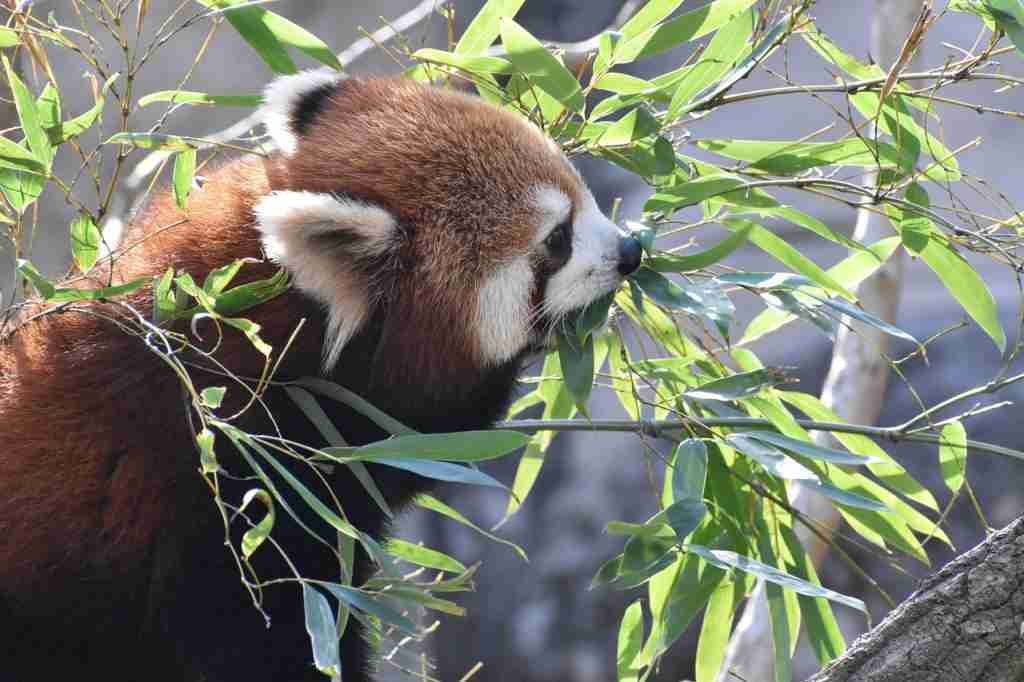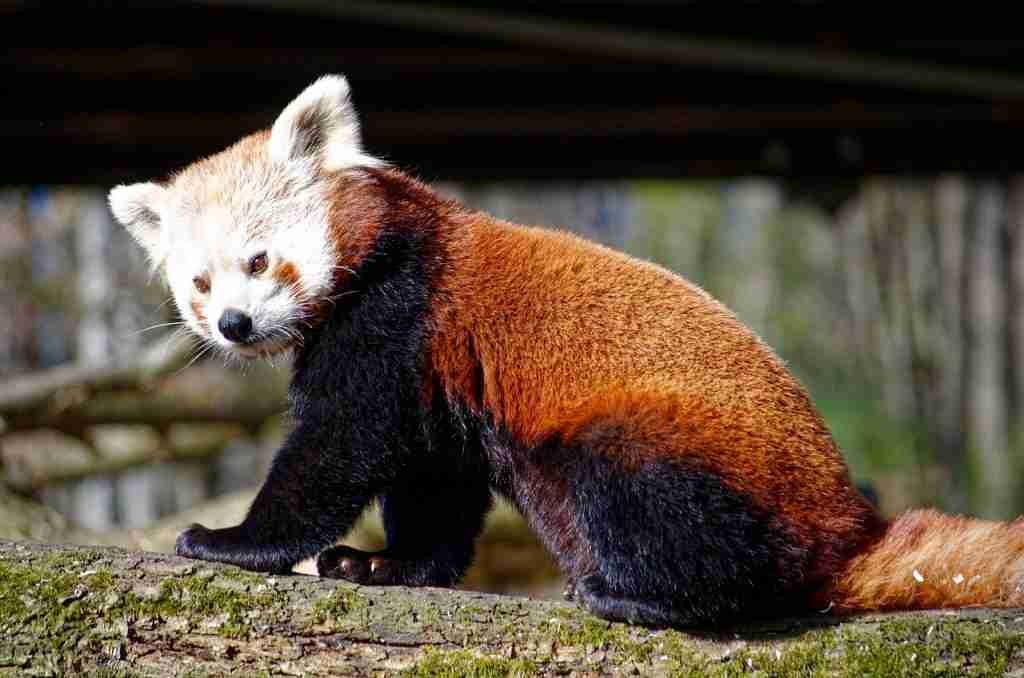Most of us are very familiar with the black-and-white panda (also known as Giant Pandas). But little did we know that there’s another kind of panda called red pandas.
In case you’re wondering, what exactly is a red panda?
Red pandas are small mammals with excellent climbing skills. They have unique reddish-brown furs, long bushy tails, and cute red and white faces.
Bear-cat, fox bear, lesser panda, Himalayan raccoon, and fire-fox are other common names of the red pandas.
In the past, the red pandas were considered as part of the raccoons because of their features. However, further studies show that these animals belong to the Ursidae family.
Current genetic studies have now classified the red pandas as belonging to Ailuridae; their own unique family.
Although these red bears share certain similarities with the giant pandas, they are different in many ways.
Now that you have an idea of what a red panda is, let’s dig a little deeper into its characteristics.
Here’s a summary of the characteristics of the red panda bears:
| Weight | 4.5 – 9kg |
| Habitat | Mountainous bamboo forests in Eastern Himalayas |
| Food | Bamboo, leaves, bird eggs, fruit, insects |
| Life Span | About 14 years |
| Reproduction | 1 – 4 young at a time |
Size
In terms of height, an average red panda is about 1 foot 8 inches – 2 feet 2 inches long from its head to the hindquarters. Usually, its tail length is between 0.917 feet – 1feet 11inches.
On the other hand, the average height of a person is 5.76 feet.
So from all indications, red pandas can be described as being unbelievably small when compared to men.
Weight
Naturally, red pandas are small creatures. They weigh around 9.92 to 19.84 lbs (4.5 to 9 kg) and are known to be slightly larger than house cats.
Usually, an adult fox bear is around 10 inches to 20.08 inches (25.4 to 51 cm) long, including its long tail. Since the red pandas spend most of their time climbing trees, their long tails help to maintain a balance.
Luckily, these red panda bears also have sharp claws that help them have firm grips on trees while climbing.
In addition, they have “false thumbs” that allow them to hold onto narrow trees to prevent falling and for holding bamboo.
So regardless of how small red pandas are, nature has designed ways for them to survive in their habitats.
Habitat
Mostly, red pandas live in the mountainous Eastern Himalayas in places such as Nepal, China, India, and Bhutan.
These habitats have two things in common; high altitudes of about 6,000 to 12,000 feet and cold temperatures, which red pandas love.
But one major factor that determines the habitat of these fox-bears is the bamboo diet. Like the giant pandas, 95% of the red pandas’ diet consists of bamboo.
Due to their solitary nature, the red pandas spend all day on tall trees either sleeping or eating bamboo. They also live comfortably in locations where temperatures do not exceed 25°C.
In very cold temperatures, the red pandas are not usually affected. All they do is wrap their long tails around their bodies and curl up into a ball-like shape to keep warm.
Apart from being a source of shade and “bed” for the red pandas, trees protect these animals from predators, especially snow leopards.
Often, their red furs serve as a form of camouflage while in their different habitats.
Furthermore, bear in mind that these pandas are crepuscular animals. This means they are always active at dawn and dusk.
That’s why they spend all day sleeping and resting on trees.
Food

Bamboo is the primary diet of the red pandas. Although they eat leaves, bird eggs, fruit, and insects, their meal is not complete without bamboo.
Even though the diet contains little nutrients, these bear-cats spend all day eating it.
Funnily, the red pandas are considered carnivores but they feed like herbivores. They have strong teeth for crushing all parts of the bamboo plant no matter how hard.
Nature also gave the pandas semi-retractile claws for holding bamboo, leaves, and tree branches while eating.
Unfortunately, the red pandas can only digest around 24% of their daily intake of bamboo. Sometimes, they eat around 2.21 to 4.41 lbs (1 to 2 kg) of the diet daily but it only provides them little energy.
Life Span
Red pandas can live for about 14 years or more, depending on many factors. These factors include comfortable habitats, good food, lack of predators, and proper care.
An example of a red panda that lived above 20 years was Taylor who lived in ZooMontana, in the USA. He died at age 22.
He was honored as the oldest red panda in captivity by Guinness World Records before his death.
Reproduction
Usually from 18 to 20 months, the red pandas reach sexual maturity. Even though these creatures are solitary animals, they relate with one another during the mating period.
To attract the females with scents, the male pandas rub their genitals on trees or urinate in an area. Sometimes, the female red panda also attracts the males with her scents and sound.
After the mating period is over, both male and female red pandas go their separate ways.
A female pandas’ pregnancy period is about 134 days. Once the time for delivery draws near, she begins to build a nest in a hollow tree or dens from leaves, sticks, and dry grass.
Normally, the pregnant red bear gives birth to an average of 1 to 4 cubs. She gives them enough attention during the first few days after birth.
With time, the mother red panda leaves the cage and comes back to take care of her young until about 90 days.
During this period, the cubs do not leave their nest until after about 3 months.
Red Panda Classification
| Kingdom | Animalia |
| Phylum | Chordata |
| Class | Mammalia |
| Order | Carnivora |
| Family | Ailuridae |
| Genus | Ailurus |
Kingdom – red pandas belong to the animal kingdom, the largest kingdom with more than a million species.
4 major factors that made these animals belong to Kingdom Animalia are:
- They have complex cells called “Eukaryotes”
- They are heterophobic, which means they have to source for their diets
- Red pandas are multicellular creatures, which means they have more than one cell unlike bacterias
- They lack cell walls
Phylum – all animals with notochords, including red pandas, fall under phylum Chordata.
4 special features that made the lesser pandas belong to the phylum Chordata category are:
- Several nerve fibers link the brain to organs and muscles also known as the dorsal nerve cord.
- A long cartilaginous rod that runs between the digestive tract and nerve cord. It is known as the notochord and majorly supports the nerve cord.
- Openings that connect the mouth to the throat which is known as the pharyngeal slits.
- The presence of a tail makes movement easy.
Class – some of the factors that made the red pandas part of mammals include:
- Furs covering their body
- 3 Middle ear bones
- 4 Chambered heart
- Females give birth to their young
Order – these fox bears belong to the order Carnivora which means “flesh eaters” in Latin. They have the digestive system of carnivores but eat like herbivores.
Family – surprisingly, red pandas are the only animal species in Ailuridae, an order of Carnivora and suborder of Carnivora.
They were formerly considered a part of Ailurus, the raccoon family due to their similar features.
Further DNA studies have placed the fox bears in their own independent family.
Genus – Ailurus fulgens is the general scientific term for the red pandas.
FAQ:
What Kind Of Animal Is A Red Panda?

Commonly, red pandas are small animals with reddish-brown furs, long tails, and sharp, semi-retractile claws. An adult bear-cat weighs around 4.5 – 9 kilograms.
They are mammals and have digestive systems of carnivores but feed like herbivores. Also, these fox bears are solitary animals; they don’t like relating with one another.
In addition, red pandas are excellent climbers. They spend most of their day on tall trees either sleeping or eating bamboo.
Why Is A Red Panda Called A Panda?
One primary reason red pandas are called pandas is because of their love for the bamboo diet.
It is popularly believed that the name “panda” originates from the Nepalese language “Nigalya ponya” which means “bamboo eater”.
Keep in mind that giant pandas got the name “panda” because they share some features with red pandas.
One of these features is their “false thumbs” that help them to hold bamboo plants well. Besides, the “thumbs” help both animals to maintain a firm grip while climbing trees.
Is A Red Panda A Mammal?
Yes, red pandas are mammals because they give birth to their young alive.
Also, they have mammary glands for feeding their young, have specialized teeth, and well-developed brains.
Red Panda Facts
Here are 13 facts about red pandas:
1. A popular internet browser known as Firefox was named after the red pandas.
2. Red pandas are not, in any way, related to giant pandas.
3. Despite having the digestive system of carnivores, red pandas feed like herbivores.
4. In the wild, red pandas have a high mortality rate. This means their babies die easily.
5. Mostly, red pandas are found in China, India, Nepal, and Tibet.
6. They are endangered species.
7. Red pandas live well in habitats with high altitudes, cold temperatures, and lots of bamboos.
8. Although they have cute faces and calm personalities, red pandas are not good as pets.
9. Red pandas can be described as arboreal animals; they spend most of their days on trees.
10. Same as giant pandas, red pandas have low birth rates.
11. Red pandas are not for sale.
12. They recognize one another by their excellent sense of smell.
13. Red panda cubs usually open their eyes about 18 days after birth.
Conclusion
We’ve come to the final part of this article. Take note of some key points before you leave.
Red pandas are small creatures with reddish-brown furs and long tails. They feed primarily on bamboo and spend their day on trees.
Also, these red cat-bears have an average lifespan of 14 years. They are good climbers and crepuscular.
Finally, red pandas love spending their time alone except during mating periods and they have low reproductive rates.
Did you find this article helpful? Share with friends on social media!

